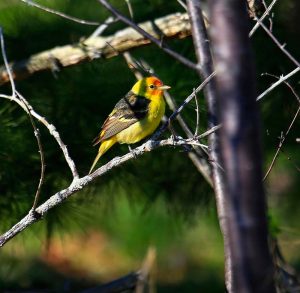(sorry for the late posting)
Article by Peggy Ridgway
For us birders, the massive spring movement of our feathered friends sends a buzz to our brains that we don’t experience at other seasons of the year! These first few weeks of May are usually the highlight as we anticipate the arrival of species that have traveled thousands of miles to reach their breeding grounds. Many come from as far away as South America or even the Bahamas. For some it’s a stop, rest, and refuel before journeying on further north. For others, Northern Michigan is their final destination and a time to set up territories , commence courtship, and raise young.
The kaleidoscope of color adorning the trees and even our backyard feeding stations is amazing. Males in their bright bold breeding plumage create an artist’s palette beyond compare. Sweet song symphonies fill the air. Many of us recognize the signature sounds and significance of each note.
However, last week there was a vocalization and appearance of a particular bird that seemed out of place in this eastern region of the country. Many birders were caught off guard by its obvious presence at the feeding station at the Tawas Pt. State Park. Its bright orange head, lemon yellow back and breast , plus black wings made observers take a second look. Could it be a Western Tanager this far east? Their usual range is Southern Alaska and the Western United States. How did that bird manage to veer this far off course? Yet, there it was right in front of the birders plain as day !
Is it possible that the strong storms across the western plains during the previous week carried it this way? It’s anybody’s guess. Yet it was a rare and awesome sighting for those who witnessed it. Few have been recorded in this eastern region of the United States, let alone at Tawas Point! How long will it stay? That’s hard to predict, but probably not long. Perhaps it will recalculate its inner GPS system and ride easterly winds back to native ground where it was first recorded during the Lewis & Clark expedition in 1803.
In the meantime, East greets West was a fabulous, memorable, once in a lifetime encounter with that gorgeous songster.



